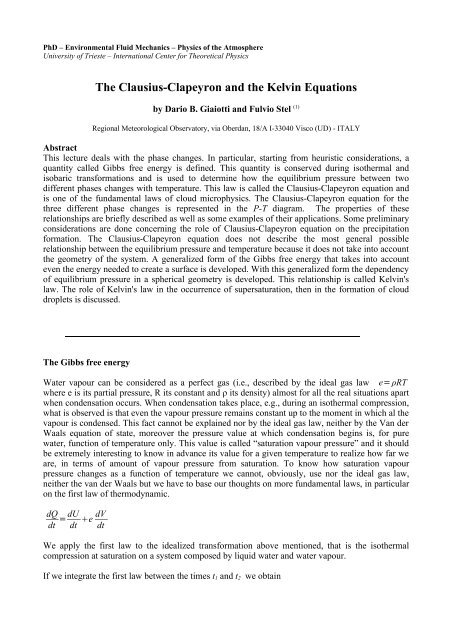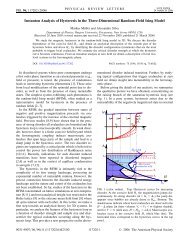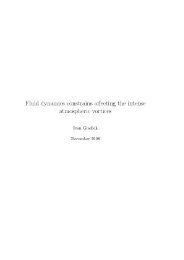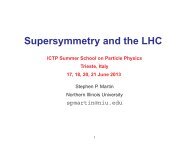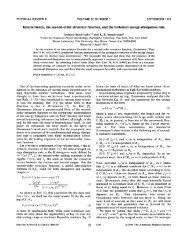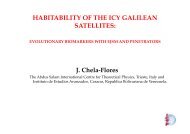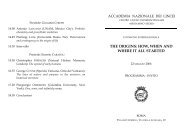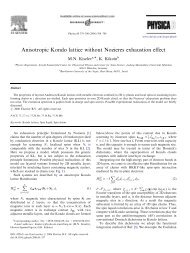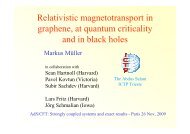The Clausius-Clapeyron and the Kelvin Equations - ICTP
The Clausius-Clapeyron and the Kelvin Equations - ICTP
The Clausius-Clapeyron and the Kelvin Equations - ICTP
You also want an ePaper? Increase the reach of your titles
YUMPU automatically turns print PDFs into web optimized ePapers that Google loves.
PhD – Environmental Fluid Mechanics – Physics of <strong>the</strong> Atmosphere<br />
University of Trieste – International Center for <strong>The</strong>oretical Physics<br />
<strong>The</strong> <strong>Clausius</strong>-<strong>Clapeyron</strong> <strong>and</strong> <strong>the</strong> <strong>Kelvin</strong> <strong>Equations</strong><br />
by Dario B. Giaiotti <strong>and</strong> Fulvio Stel (1)<br />
Regional Meteorological Observatory, via Oberdan, 18/A I-33040 Visco (UD) - ITALY<br />
Abstract<br />
This lecture deals with <strong>the</strong> phase changes. In particular, starting from heuristic considerations, a<br />
quantity called Gibbs free energy is defined. This quantity is conserved during iso<strong>the</strong>rmal <strong>and</strong><br />
isobaric transformations <strong>and</strong> is used to determine how <strong>the</strong> equilibrium pressure between two<br />
different phases changes with temperature. This law is called <strong>the</strong> <strong>Clausius</strong>-<strong>Clapeyron</strong> equation <strong>and</strong><br />
is one of <strong>the</strong> fundamental laws of cloud microphysics. <strong>The</strong> <strong>Clausius</strong>-<strong>Clapeyron</strong> equation for <strong>the</strong><br />
three different phase changes is represented in <strong>the</strong> P-T diagram. <strong>The</strong> properties of <strong>the</strong>se<br />
relationships are briefly described as well as some examples of <strong>the</strong>ir applications. Some preliminary<br />
considerations are done concerning <strong>the</strong> role of <strong>Clausius</strong>-<strong>Clapeyron</strong> equation on <strong>the</strong> precipitation<br />
formation. <strong>The</strong> <strong>Clausius</strong>-<strong>Clapeyron</strong> equation does not describe <strong>the</strong> most general possible<br />
relationship between <strong>the</strong> equilibrium pressure <strong>and</strong> temperature because it does not take into account<br />
<strong>the</strong> geometry of <strong>the</strong> system. A generalized form of <strong>the</strong> Gibbs free energy that takes into account<br />
even <strong>the</strong> energy needed to create a surface is developed. With this generalized form <strong>the</strong> dependency<br />
of equilibrium pressure in a spherical geometry is developed. This relationship is called <strong>Kelvin</strong>'s<br />
law. <strong>The</strong> role of <strong>Kelvin</strong>'s law in <strong>the</strong> occurrence of supersaturation, <strong>the</strong>n in <strong>the</strong> formation of cloud<br />
droplets is discussed.<br />
<strong>The</strong> Gibbs free energy<br />
Water vapour can be considered as a perfect gas (i.e., described by <strong>the</strong> ideal gas law e= ρRT<br />
where e is its partial pressure, R its constant <strong>and</strong> ρ its density) almost for all <strong>the</strong> real situations apart<br />
when condensation occurs. When condensation takes place, e.g., during an iso<strong>the</strong>rmal compression,<br />
what is observed is that even <strong>the</strong> vapour pressure remains constant up to <strong>the</strong> moment in which al <strong>the</strong><br />
vapour is condensed. This fact cannot be explained nor by <strong>the</strong> ideal gas law, nei<strong>the</strong>r by <strong>the</strong> Van der<br />
Waals equation of state, moreover <strong>the</strong> pressure value at which condensation begins is, for pure<br />
water, function of temperature only. This value is called “saturation vapour pressure” <strong>and</strong> it should<br />
be extremely interesting to know in advance its value for a given temperature to realize how far we<br />
are, in terms of amount of vapour pressure from saturation. To know how saturation vapour<br />
pressure changes as a function of temperature we cannot, obviously, use nor <strong>the</strong> ideal gas law,<br />
nei<strong>the</strong>r <strong>the</strong> van der Waals but we have to base our thoughts on more fundamental laws, in particular<br />
on <strong>the</strong> first law of <strong>the</strong>rmodynamic.<br />
dQ dU dV<br />
= e<br />
dt dt dt<br />
We apply <strong>the</strong> first law to <strong>the</strong> idealized transformation above mentioned, that is <strong>the</strong> iso<strong>the</strong>rmal<br />
compression at saturation on a system composed by liquid water <strong>and</strong> water vapour.<br />
If we integrate <strong>the</strong> first law between <strong>the</strong> times t1 <strong>and</strong> t2 we obtain
t2 dQ<br />
∫t1 dt dt=∫<br />
t2 dU<br />
t1 dt dt∫<br />
t2<br />
e<br />
t1<br />
dV<br />
dt dt .<br />
Because in <strong>the</strong> above transformation (constant temperature) during <strong>the</strong> condensation e remains<br />
constant, defining as l <strong>the</strong> amount of heat released (absorbed) when a unitary mass of vapour is<br />
condensed (evaporated), we can write<br />
l Δ M =U t 2 −U t 1 eV t 2 −V t 1 <br />
dividing by <strong>the</strong> total amount of water vapour ΔM condensed <strong>and</strong> introducing <strong>the</strong> specific variables<br />
for internal energy <strong>and</strong> volume (i.e., u <strong>and</strong> α) we have<br />
l=ut 2 −ut 1 eαt 2 −αt 1 .<br />
At this point it is useful to introduce <strong>the</strong> specific entropy s for unit mass defined as<br />
ds 1<br />
=<br />
dt T<br />
dq<br />
dt<br />
Because in <strong>the</strong> above transformation temperature T is kept constant, integrating <strong>the</strong> specific<br />
temperature between <strong>the</strong> same times t1 <strong>and</strong> t2 we obtain<br />
t2 ds<br />
∫t1 dt dt=∫<br />
t2 1<br />
t1 T<br />
that is<br />
st 2−st 1=∫t1 T<br />
or equivalently<br />
dq<br />
dt dt<br />
t2 1<br />
T st 2 −st 1 =∫ t1<br />
dq<br />
dt<br />
t2 dq<br />
dt= 1<br />
T l<br />
dt dt=l<br />
Equating <strong>the</strong> two specific latent heats we obtain <strong>the</strong> relationship<br />
T st 2−st 1=ut 2−ut 1eαt 2−αt 1<br />
that rearranged becomes<br />
ut 1 e αt 1 −T st 1 =ut 2 e αt 2 −T st 2 <br />
which states that we can define a quantity (usually denoted by <strong>the</strong> g letter) which is constant during<br />
<strong>the</strong> phase transitions (in isobaric <strong>and</strong> iso<strong>the</strong>rmal transformations). This quantity is called Gibbs free<br />
energy (i.e., g = u + pα - Ts) <strong>and</strong> it is essentially <strong>the</strong> specific enthalpy (i.e., h = u + pα) diminished<br />
by <strong>the</strong> product of temperature for specific entropy (i.e., Ts).<br />
Thanks to its constance during phase transitions, specific Gibbs internal energy can be used to<br />
describe how <strong>the</strong> saturation vapour pressure changes with temperature, in fact <strong>the</strong> specific Gibbs<br />
free energy is constant for <strong>the</strong> two phases (vapour <strong>and</strong> liquid), <strong>the</strong>n we can write<br />
dgl dT = dgv dT
equation that, using <strong>the</strong> definition of Gibbs free energy, becomes<br />
d<br />
dT ueα−Ts d<br />
l =<br />
dT ueα−Tsv exp<strong>and</strong>ing <strong>the</strong> derivatives we obtain<br />
dul dT del dT αle dαl l<br />
dT −sl −T dsl dT = duv dT dev dT αve dαv v<br />
dT −s v−T dsv dT<br />
or equivalently<br />
dul dT e dαl l<br />
dT del dT αl−s l−T dsl dT = duv dT e dαv v<br />
dT dev dT αv −sv−T dsv dT<br />
<strong>the</strong>n applying <strong>the</strong> following form of <strong>the</strong> first law of <strong>the</strong>rmodynamics<br />
dq<br />
dT<br />
dT<br />
dt<br />
du dv dT<br />
= e <br />
dT dT dt<br />
<strong>and</strong> <strong>the</strong> following definition of entropy<br />
ds<br />
dT<br />
dT<br />
dt<br />
= 1<br />
T<br />
dq<br />
dT<br />
dT<br />
dt<br />
both based on <strong>the</strong> fact that <strong>the</strong> only quantity we varies is temperature, <strong>the</strong> above equation becomes<br />
dql dT del dT αl−s l− dql dT =dq v<br />
dT dev dT αv−s v− dqv dT<br />
<strong>the</strong>n<br />
de l<br />
dT α l −s l = de v<br />
dT α v −s v .<br />
Since <strong>the</strong> vapour <strong>and</strong> liquid pressure are <strong>the</strong> same, i.e., <strong>the</strong> saturation vapour pressure e v =e l ≡e s ,<br />
we obtain<br />
de s<br />
dT = s v −s l<br />
α v−α l<br />
This equation solves formally our problem, because it gives a defined form for <strong>the</strong> variation of<br />
saturation vapour pressure with temperature, moreover it gives us useful hints for <strong>the</strong> physical<br />
interpretation of <strong>the</strong> saturation vapour pressure derivative. In fact we can say that <strong>the</strong> rate of change<br />
of saturation vapour pressure with temperature is <strong>the</strong> entropy rate of change for <strong>the</strong> given change in<br />
specific volume in <strong>the</strong> transition between <strong>the</strong> two phases. In o<strong>the</strong>r words we can say that saturation<br />
vapour pressure changes (increases) with temperature because specific entropy increases with<br />
temperature more in vapour than in liquid phase. Apart from its interesting physical interpretation<br />
<strong>the</strong> above equation is still in a poorly useful form. A better form can be easily obtained<br />
remembering <strong>the</strong> result we obtained to define <strong>the</strong> Gibbs internal energy, i.e., <strong>the</strong> difference in <strong>the</strong><br />
specific entropies of liquid <strong>and</strong> solid water during <strong>the</strong> phase transition is <strong>the</strong> specific latent heat of
vaporization (condensation) divided by <strong>the</strong> temperature at which <strong>the</strong> transition takes place. With<br />
this in mind we obtain<br />
des 1<br />
=<br />
dT T<br />
l<br />
α v−α l<br />
which is <strong>the</strong> usually adopted functional dependence of saturation vapour pressure from absolute<br />
temperature, universally known as <strong>Clausius</strong>-<strong>Clapeyron</strong> equation. This equation mutatis mut<strong>and</strong>is<br />
can be used to describe all <strong>the</strong> change of phase from vapour to liquid, from vapour to solid <strong>and</strong> from<br />
liquid to solid. In <strong>the</strong> latter cases latent heats of sublimation <strong>and</strong> solidification (i.e., sublimation<br />
minus condensation) have to be used instead of latent heat of condensation. This equation can be<br />
integrated in principle but practically this can be done only assuming a functional dependency from<br />
temperature of latent heats <strong>and</strong> specific volumes. Some considerations, however, can be done even<br />
without <strong>the</strong> integration. In particular usually, being latent heats positive defined, <strong>the</strong> saturation<br />
pressure increases or decreases with temperature according to <strong>the</strong> interplay between <strong>the</strong> specific<br />
volumes of <strong>the</strong> two phases. In o<strong>the</strong>r words, usually saturation pressure for vapour <strong>and</strong> liquid phases<br />
increases with temperature because vapour density is lower than liquid density. <strong>The</strong> same happens<br />
for many liquid <strong>and</strong> solid phases, apart from water because its density is lower for ice than for<br />
liquid<br />
As told before, <strong>the</strong> water <strong>Clausius</strong>-<strong>Clapeyron</strong> equation for <strong>the</strong> usual atmospheric conditions can be<br />
quite easily integrated with a few simple assumptions. <strong>The</strong> simplest possible situation is that of<br />
vapour <strong>and</strong> liquid phases. We start assuming that latent heat of condensation is constant with<br />
temperature <strong>and</strong> that liquid water specific volume (inverse of density) can be neglected when<br />
compared with vapour specific volume. Water latent heat of condensation changes by about 6%<br />
from its l=2501 J / g at 0 °C . We can go a step fur<strong>the</strong>r just using one more assumption, that is <strong>the</strong><br />
ideal gas law for <strong>the</strong> water vapour to describe <strong>the</strong> functional dependence of αv from temperature,<br />
i.e., eα v = RT . With <strong>the</strong>se assumptions <strong>the</strong> <strong>Clausius</strong>-<strong>Clapeyron</strong> equation becomes<br />
des 1<br />
≃<br />
dT T<br />
l<br />
α v<br />
≃ 1<br />
T<br />
l e s<br />
RT = l e s<br />
RT 2<br />
which can be easily integrated giving an exponential dependence of es from temperature. A greater<br />
accuracy (i.e., ability of reproducing reality) can be obtained introducing into <strong>the</strong> above equation<br />
<strong>the</strong> dependence of latent heat from temperature. This can be easily done using <strong>the</strong> first law of<br />
<strong>the</strong>rmodynamics <strong>and</strong> in particular a result we obtained in defining <strong>the</strong> Gibbs free energy to<br />
determine <strong>the</strong> latent heat of condensation, that is<br />
l=ut 2 −ut 1 eαt 2 −αt 1 <br />
where <strong>the</strong> index t1 is referring to <strong>the</strong> liquid phase while t2 to <strong>the</strong> vapour one (in this way l is<br />
positive). This equation can be simplified remembering that α 2 ≫α 1 <strong>and</strong> confusing again water<br />
vapour with an ideal gas, <strong>the</strong>n<br />
l=ut 2 −ut 1 eαt 1 =ut 2 −ut 1 RT<br />
Differentiating <strong>the</strong> above equation with respect to temperature, we obtain<br />
dl d<br />
=<br />
dT dT ut 2− d<br />
dT ut 1 d<br />
dT<br />
RT <br />
remembering that u(t2) <strong>and</strong> u(t1) are <strong>the</strong> internal energies of liquid water <strong>and</strong> water vapour, by
definition <strong>the</strong>ir derivatives represent <strong>the</strong> specific heats of water vapour at constant volume c vv<br />
(remember that we still consider vapour as an ideal gas) <strong>and</strong> <strong>the</strong> specific heat of water c w . <strong>The</strong>n we<br />
obtain<br />
dl<br />
dT =c vv −c w R<br />
or, remembering that R=c pv −c vv<br />
dl<br />
dT =c pv−c w<br />
which states us that if you do not want to consider constant with temperature <strong>the</strong> latent heat of<br />
condensation, you can at least consider constant with temperature its derivative. <strong>The</strong>n, fixing a<br />
reference status l 0 ,T 0 , we can obtain <strong>the</strong> functional dependence of latent heat from temperature<br />
l=c pv −c w T −T 0 l 0<br />
that can be used into <strong>the</strong> <strong>Clausius</strong>-<strong>Clapeyron</strong> equation to obtain a preciser dependency of saturation<br />
vapour pressure from temperature. Apart from this specific use, <strong>the</strong> above equation tells us that<br />
Δl=c pv ΔT −c w ΔT =ΔQ pv − ΔQ w<br />
which means that when temperature changes <strong>the</strong> variations in latent heat of condensation is equal to<br />
<strong>the</strong> difference in <strong>the</strong> amount of heat absorbed (released) by two unitary masses of vapour <strong>and</strong> liquid<br />
water at constant pressure. This is not surprising, since that difference in heats has to be released<br />
(absorbed) when water vapour is made to condense (evaporate) keeping constant temperature<br />
(remember that condensation is a constant pressure process).<br />
Before to conclude <strong>the</strong> discussion on <strong>the</strong> <strong>Clausius</strong>-<strong>Clapeyron</strong> equation it is just worth to spend a<br />
few more words on <strong>the</strong> liquid <strong>and</strong> solid transitions of phase. For <strong>the</strong>m <strong>the</strong> equation assumes <strong>the</strong><br />
form<br />
des 1<br />
=<br />
dT T<br />
l<br />
α l−α i<br />
where l in this case is <strong>the</strong> latent heat of solidification <strong>and</strong> es in this case is <strong>the</strong> pressure exerted by<br />
liquid over solid phase when <strong>the</strong>y are in equilibrium (i.e., nor increasing of liquid part nei<strong>the</strong>r solid<br />
one for a closed system). It is interesting to apply this equation to water because, since T <strong>and</strong> l are<br />
positive defined, <strong>the</strong> sign of <strong>the</strong> derivative (i.e., <strong>the</strong> slope of es in <strong>the</strong> PT diagram) is that of (α_l -<br />
α_i). For water this is negative since ice density is lower than liquid one. With this in mind we can<br />
produce <strong>the</strong> PT diagram for <strong>the</strong> three phases (liquid, solid <strong>and</strong> vapour) of water.
Pressure (hPa)<br />
7.00<br />
6.75<br />
6.50<br />
6.25<br />
6.00<br />
5.75<br />
5.50<br />
5.25<br />
5.00<br />
4.75<br />
4.50<br />
4.25<br />
4.00<br />
-5 -4 -3 -2 -1 0 1 2 3 4 5<br />
Temperature (C)<br />
From <strong>the</strong> above picture it is quite clear that equilibrium pressure over liquid is slightly higher over<br />
liquid than over ice. From <strong>the</strong> molecular point of view this means that water molecules escape<br />
easily from water than from ice, <strong>the</strong>n reaching far<strong>the</strong>r (i.e, for higher pressures) <strong>the</strong> equilibrium with<br />
<strong>the</strong> vapour.<br />
Concerning <strong>the</strong> equilibrium pressure between liquid <strong>and</strong> solid, as described above, it decreases with<br />
increasing temperature. According to our naïve interpretation, we can imagine that for a fixed<br />
negative temperature you have to compress a lot ice to reduce its density -<strong>the</strong>n reducing <strong>the</strong><br />
intramolecular distances- making a little bit easy <strong>the</strong>ir escape from <strong>the</strong> ice phase in favour of <strong>the</strong><br />
liquid one. <strong>The</strong> slope of equilibrium pressure between solid <strong>and</strong> liquid phase in <strong>the</strong> P-T diagram is<br />
pretty steep (almost vertical) of <strong>the</strong> order of de s/dT~−10 5 hPa K −1<br />
, inverting it we can see that<br />
freezing level decreases by nearly ΔT ~ 0.01 K when we increase pressure by one atmosphere (1013<br />
hPa). This means that you can find liquid water even below <strong>the</strong> classical freezing level just<br />
increasing (a lot) pressure. However <strong>the</strong> sensitivity of melting point from pressure is so low that<br />
only in systems characterized by high pressures can take advantage from this mechanism. <strong>The</strong><br />
classical example is represented by glaciers, whose base can host a thin liquid layer even for<br />
negative Celsius temperatures. Of course, dealing with glaciers composed by o<strong>the</strong>r substances, e.g.<br />
C02, as can happen in o<strong>the</strong>r planets, this effect might not take place when <strong>the</strong> solid phase of <strong>the</strong><br />
specific substance has a higher density than <strong>the</strong> liquid one.<br />
All <strong>the</strong> three equilibrium pressures for all <strong>the</strong> substances intersect on a point (called triple point) that<br />
for water coincides with <strong>the</strong> zero Celsius (i.e., 273.15 K). At <strong>the</strong> triple point all <strong>the</strong> three phases can<br />
coexist. <strong>The</strong> triple point is <strong>the</strong> key quantity when dealing with changes of phase, in fact as shown in<br />
<strong>the</strong> previous lectures, even if at st<strong>and</strong>ard atmospheric pressures both water <strong>and</strong> carbon dioxide are<br />
vapours, <strong>the</strong>ir behaviour is quite different. We have to take care of water vapour for <strong>the</strong> change of<br />
phase, while we can almost forget carbon dioxide. <strong>The</strong> reason why this happens is that <strong>the</strong> triple<br />
point for carbon dioxide (~216.5 K, -56 ºC) is lower than for water. Is <strong>the</strong> distance from <strong>the</strong> triple<br />
e_liq<br />
e_ice<br />
p_ice<br />
Figure. Water equilibrium pressures of liquid over solid (solid blue line), of vapour over liquid<br />
(dashed red line) <strong>and</strong> of vapour over solid (solid green).
point that makes impossible <strong>the</strong> phase transition of <strong>the</strong> carbon dioxide, o<strong>the</strong>rwise we should take<br />
care even of its latent heat of evaporation (lv ~ 574 J/kg) <strong>and</strong> of solidification (ls ~ 184 J/kg) to<br />
underst<strong>and</strong> <strong>and</strong> forecast <strong>the</strong> atmospheric behaviour.<br />
Table. Saturation vapour pressure over liquid water, ice <strong>and</strong> <strong>the</strong> corresponding latent heats. Reproduced<br />
from <strong>the</strong> Smithsonian Meteorological Tables (List, 1951).<br />
T °C e_s (Pa) e _i (Pa) L_v->l (J/kg) L_v->s (J/kg) L_l->s(J/kg)<br />
-40 19.5 12.85 2603 2839 236<br />
-35 31.54 22.36 - - -<br />
-30 51.06 38.02 2575 2839 264<br />
-25 80.9 63.3 - - -<br />
-20 125.63 103.28 2549 2838 289<br />
-15 191.44 165.32 - - -<br />
-10 286.57 259.92 2525 2837 312<br />
-5 421.84 401.78 - - -<br />
0 611.21 611.15 2501 2834 333<br />
5 872.47 2489<br />
10 1227.94 2477<br />
15 1705.32 2466<br />
20 2338.54 2453<br />
25 3168.74 2442<br />
30 4245.2 2430<br />
35 5626.45 2418<br />
40 7381.27 2406<br />
<strong>The</strong> dependence of saturation vapour pressure from geometry<br />
Obtaining <strong>the</strong> <strong>Clausius</strong>-<strong>Clapeyron</strong> equation <strong>and</strong> <strong>the</strong> dependence of equilibrium pressure from<br />
temperature we use <strong>the</strong> free energy of Gibbs. This free energy is conserved during <strong>the</strong> bulk<br />
transition between vapour <strong>and</strong> liquid as demonstrated above. However, in some circumstances (very<br />
often observed in nature), dealing with bulk phases is not enough, in fact geometry may play a<br />
major role. We can tackle <strong>the</strong> problem just with some heuristic considerations, in fact if we want to<br />
split a water droplet in two parts we have to spend energy. This expenditure of energy is needed to<br />
break <strong>the</strong> links between water molecules to produce two distinct parts. But we can consider this<br />
energy expenditure as due to <strong>the</strong> formation of a greater surface enveloping water. Even if this can<br />
seem counter-intuitive, it is particularly convenient under <strong>the</strong> analytical point of view.<br />
Returning back to our initial problem, defining as gv <strong>and</strong> gw <strong>the</strong> Gibbs free energies for unit mass of<br />
water vapour <strong>and</strong> liquid water respectively, assuming that <strong>the</strong> energy required to produce a unit<br />
surface of liquid phase is σ, <strong>the</strong> conservation of total energy requires<br />
d<br />
dt M v g v M w g w σ A =0<br />
where A is <strong>the</strong> surface of liquid phase <strong>and</strong> Mw <strong>and</strong> Mv are respectively <strong>the</strong> masses of liquid <strong>and</strong><br />
vapour phases.<br />
Mass conservation during phase transition requires that
d<br />
dt M v =− d<br />
dt M w <br />
<strong>the</strong>n exp<strong>and</strong>ing <strong>the</strong> above derivative we obtain<br />
g w−g v dM w d<br />
σ<br />
dt A dt=0<br />
Assuming a spherical geometry we can express <strong>the</strong> water mass as a function of water density ρ <strong>and</strong><br />
of <strong>the</strong> droplet radius r. Moreover we can rewrite even <strong>the</strong> droplet surface obtaining<br />
g w −g v ρ w<br />
4<br />
3<br />
2 dr dr<br />
π 3r σ 4π 2r<br />
dt dt =0<br />
where we assumed constant both <strong>the</strong> surface energy for unit surface <strong>and</strong> <strong>the</strong> density. Simplifying we<br />
obtain<br />
g w−g 2σ<br />
v rρ w dr<br />
dt =0<br />
Since energy has to be conserved independently from <strong>the</strong> radius variation with time, we can<br />
conclude that<br />
g v=g w 2σ<br />
rρ w<br />
This equation means that not all <strong>the</strong> bulk Gibbs free energy of vapour transfers into <strong>the</strong> liquid phase<br />
(per unit mass): an amount of it is spent in producing <strong>the</strong> surface. If <strong>the</strong> droplet radius diverge<br />
(infinite curvature, e.g., a “plane” droplet), we return back to what we used at <strong>the</strong> beginning of this<br />
lecture. To obtain <strong>the</strong> equilibrium pressure dependence from <strong>the</strong> geometry (radius in this case), we<br />
will now use <strong>the</strong> above generalize version of <strong>the</strong> Gibbs free energy conservation. In particular we<br />
will differentiate with respect to <strong>the</strong> radius r.<br />
dg v<br />
dr = dg w<br />
dr<br />
d<br />
dr 2σ<br />
rρ w <br />
To exp<strong>and</strong> this derivative we have to remember that Gibbs free energy depend only from pressure p<br />
<strong>and</strong> temperature T (which we consider not dependent from radius), <strong>the</strong>n<br />
∂ g v<br />
∂ p<br />
dp<br />
dr = ∂ g w<br />
∂ p<br />
dp 2<br />
−<br />
dr r 2<br />
σ<br />
ρ w<br />
from <strong>the</strong> functional dependency of specific Gibbs free energy we have<br />
∂ g v 1<br />
=<br />
∂ p ρv <strong>and</strong><br />
∂ g w 1<br />
=<br />
∂ p ρw <strong>The</strong>n with simple algebra we obtain<br />
dp 2σ<br />
=−<br />
dr r 2 <br />
ρv ρw− ρ <br />
v
Remembering that at ordinary atmospheric conditions water vapour can be considered an ideal gas,<br />
we can write vapour density as a function of pressure <strong>and</strong> temperature, that is<br />
ρ v = p<br />
R vT<br />
With relatively simple algebra we obtain <strong>the</strong> following differential equation<br />
ρ w R v T − p<br />
p<br />
dp 2σ<br />
=−<br />
dr r 2<br />
which can be solved integrating it from a generic radius r up to an infinite radius, giving<br />
ln p 2 σ<br />
p =<br />
∞ r ρw R vT ρv p− p∞ ρw p<br />
Since water density is higher than vapour density we can delete <strong>the</strong> last term on <strong>the</strong> right member<br />
obtaining <strong>the</strong> so called <strong>Kelvin</strong> law for <strong>the</strong> equilibrium pressure:<br />
p= p ∞e<br />
2σ<br />
r ρ R T w v<br />
<strong>The</strong> interpretation of p∞ is quite straightforward, remembering that <strong>the</strong> infinite radius corresponds<br />
to a flat surface. In o<strong>the</strong>r words it is <strong>the</strong> bulk equilibrium pressure we obtained with <strong>the</strong> <strong>Clausius</strong><br />
<strong>Clapeyron</strong> equation.<br />
Using <strong>the</strong> values normally observed in atmospheric conditions for <strong>the</strong> above <strong>Kelvin</strong>'s law (Rv = 461<br />
J/kg K ; σ = 0.0073 N m <strong>and</strong> ρw = 10 3 kg/m 3 ) we obtain<br />
0.001<br />
r<br />
p= p∞e where r is measured in microns.<br />
From <strong>the</strong> above law it is clear that differences in <strong>the</strong> saturation (equilibrium) vapour pressure over<br />
water is really a weak function of radius. Never<strong>the</strong>less this dependence is extremely important foe<br />
<strong>the</strong> development of cloud droplets <strong>and</strong> <strong>the</strong>n <strong>the</strong> formation of precipitations. In particular it is clear<br />
that <strong>the</strong> saturation vapour pressure required to admit <strong>the</strong> formation of droplets of <strong>the</strong> order of a few<br />
hundredths of micron is extremely high, more than twice <strong>the</strong> maximum observed in nature. This<br />
means that condensation of water vapour is extremely difficult. Very small droplets can form easily<br />
under <strong>the</strong> statistical point of view, but <strong>the</strong>y are stable only for very high pressures. On <strong>the</strong> contrary<br />
<strong>the</strong> pressure required for <strong>the</strong> equilibrium of large droplets (a few microns) is not so high, but <strong>the</strong>y<br />
are statistically disadvantaged. This is <strong>the</strong> reason why condensation of pure water vapour<br />
(homogeneous condensation or nucleation) is quite rare in nature <strong>and</strong> <strong>the</strong> formation of clouds has to<br />
take place for different reasons, in particular we need what is called heterogeneous condensation<br />
which requires <strong>the</strong> presence of condensation nuclei. <strong>The</strong> same is true for <strong>the</strong> solid phase formation.
Figure. <strong>The</strong> ratio between equilibrium pressure for water over a spherical <strong>and</strong> flat surface as a<br />
function of <strong>the</strong> sphere radius.<br />
p/p_inf<br />
2.8<br />
2.6<br />
2.4<br />
2.2<br />
2<br />
1.8<br />
1.6<br />
1.4<br />
1.2<br />
p/p∞<br />
1<br />
0.001 0.010 0.100 1.000 10.000<br />
r (μm)


